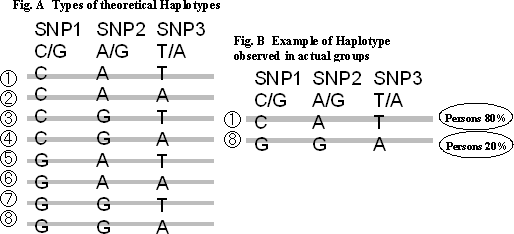About 99.9% of the base sequence of the human genome is the same, even among non-relatives. The difference of individuals is in the remaining 0.1%, and a part of it is thought to be connected with the difference of individuals relating to the risks of diseases or sensitivity to medicines. Analysis made by connecting the location of the variety of human genes or their patterns and the development of diseases or reactivity to medicines may lead to the clarification of pathogenesis and development of new treatments. For this purpose, a genome map that shows the variety of genes is necessary.
SNPs (Single Nucleotide Polymorphisms) are an index to show variety in the genome. SNPs are the difference of four (A, T, G, and C) types of bases, i.e. some people have A and others have G at a certain location. In an entire human being, there are SNPs in several hundreds of base pairs, and about 10 million SNPs in total are considered to exist throughout the whole genome.
To find medically important polymorphisms from about 10 million SNPs, it is not necessarily required to check all SNPs. Because the genes or SNPs linking close on a chromosome are passed from parents to children, it is effective to check individual differences by using a combination called Haplotype (Reference). The Haplotype Map was made by an international joint group of 14 centers in 5 countries, Japan, the U.S., U.K., Canada, and China. From Japan, the RIKEN SNP Research Center participated and was assigned the analysis of 7 chromosomes which are equivalent to 24.7% of the genome.
This project was completed in October 2005. Using a sample of 269 people from Africa, Asia including Japan, and Europe, SNPs of about 1.1 million locations were analyzed and a high-density Haplotype Map with at least one SNP located in each of 5,000 base pairs was made.
As a result of this project, it became clear that, with Japanese and Chinese people that a race composing a group is comparatively uniform, checking SNPs at 250,000 locations covers 98.5% of the entire genome of 10 million locations. Cancers and adult diseases are caused by a combination of several genetic factors and environmental factors. By the completion of this Haplotype Map, it is expected that genetic research related to such frequent diseases and effects and side effects of medicines will become more efficient, and that the discovery of genetic factors may lead to innovative diagnosis and the development of cures.
(Reference)

As shown in Fig. A, when SNPs (Single Nucleotide Polymorphisms) exist at three locations, there are theoretically eight kinds of combinations on one chromosome. However, if the physical distances among three polymorphisms are comparatively close, it is often the case that only some kinds of Haplotypes are seen, as shown in Fig. B. The situation is different depending on the location on the chromosome, and it is necessary to understand the entire genome area.
Contacts
Research and Coordination Division, Science and Technology Policy Bureau
(Research and Coordination Division, Science and Technology Policy Bureau)




